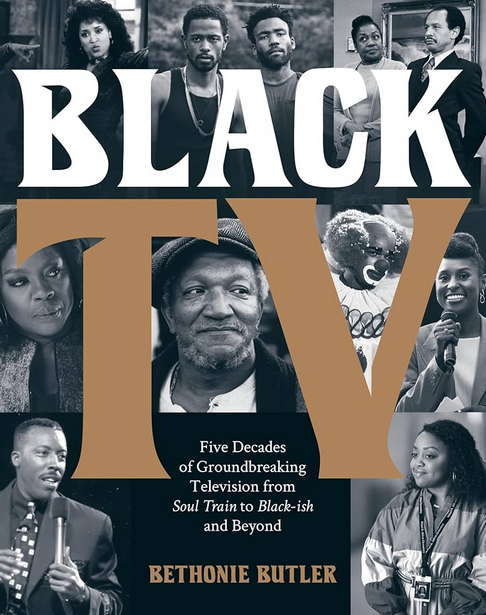Black TV: Five Decades of Groundbreaking Television from Soul Train to Black-ish and Beyond
- By Bethonie Butler
- Black Dog & Leventhal
- 288 pp.
- Reviewed by Chris Rutledge
- December 13, 2023
A stellar ode to some of entertainment’s true trailblazers.

Bethonie Butler’s Black TV is an intelligent, valuable resource for anyone interested in learning more about the history of (and trends evolving from) the African-American experience on television. More than an encyclopedia, this thoughtful book looks at how Black people have been portrayed on the small screen and how those depictions have both changed with and influenced the times.
The author is well suited to address this material. For more than a decade, she has covered pop culture and entertainment for the Washington Post and brings her breadth of knowledge to the book. One of the throughlines here is the importance of authorial voice and authenticity on television. Norman Lear, who died last week, was an example of a white producer who sought to present a more diverse picture, but even he perpetuated the white voice, staffing his writers’ rooms with few, if any, people of color. This often led to the Black stars of Black shows being presented with scripts that demonstrated a dismal lack of understanding of their lives.
The first season of “Sanford and Son,” for instance, featured an all-white writing team. White producer Aaron Ruben said he wished to hire Black writers but found it “a near impossible task.” Really? He must not have been looking too hard, because Fred Sanford himself, Redd Foxx, found several to join the show in later seasons.
The hit comedy “Good Times” did a little better at adding Black writers, but even its creators were predominantly white. This led to the central vantage point of the show veering away from the Black parents (which is what stars John Amos and Esther Rolle had signed up for) in favor of the caricature-like Jimmie Walker and his catchphrase, “Dyn-o-mite!” It seemed a serious Black actor couldn’t win.
This led to the sense of responsibility felt by those who did “make it.” Butler shares the stories of stars who fronted shows and who saw that they could make a profound difference in the lives of fellow entertainers. Among the earliest examples was Flip Wilson, who used his platform to give exposure both to new artists — including Richard Pryor, the Jackson 5, and Roberta Flack — and to past-their-prime performers like Moms Mabley.
Wilson, for his part, was given a similar hand up when Johnny Carson asked Redd Foxx who was the funniest working comedian, and Foxx named Wilson. It was like lighting a rocket in the latter’s career. Likewise, Pryor and Foxx would go on to hire and promote talents such as Paul Mooney.
Another ongoing theme in the book is the importance of ownership, not just in terms of content, but in the actual intellectual-property rights to shows. Wilson led the way on this, insisting on owning the syndication rights to his eponymous show and thereby guaranteeing his future income. Too often, producers exploit talent (across all media) by shutting them out of the business-decision-making process. This is especially true with the white creators of Black shows. Here again, Wilson was a pioneer and a role model: By making himself the producer of his own show, he was assured a seat at the table.
Butler isn’t afraid to criticize big stars, however. She doesn’t shy away from the controversies surrounding fallen icon Bill Cosby, noting the impact he had on television while also discussing how allegations of longtime sexual misconduct have tarnished his legacy. She also gives ample voice to those who would disparage those performers — like Martin Lawrence and the Wayans Brothers — whose shows devolved into something like modern minstrels, sharing concerns from folks who took (and still take) offense at such shows playing into Black stereotypes.
Equally considered is the role of white audiences. More specifically, how uncomfortable should a Black performer be if a white audience member laughs a bit too loudly at a race-based depiction? Dave Chappelle relates a sketch in which he played a Black pixie in blackface. He found the skit funny but then noticed a white spectator laughing heartily at it. “When he laughed, it made me uncomfortable,” recalls Chappelle. “That was the last thing I shot before I told myself I gotta take…time out.” Later, he told Oprah that he felt he “was doing sketches that were funny, but socially irresponsible.”
The author does a great job tying all of these themes together. Because of her skill, what could’ve been a scattershot compendium of beloved television nostalgia is instead an insightful, sweeping history. Readers of Black TV will find much to appreciate and enjoy in its pages.
Chris Rutledge is a husband, father, writer, nonprofit professional, and community member living in Silver Spring, MD. Besides the Independent, his work has appeared in Kirkus Reviews, American Book Review, and countless intemperate Facebook posts, which will surely get him into trouble one day.

